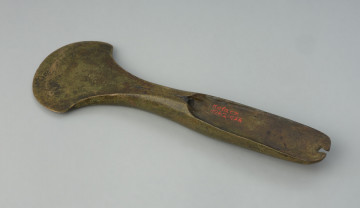
An axe with a heel
around 1600 p.n.e. — 1300 p.n.e.
National Museum in Szczecin
Part of the collection: Bronze Age
The presented dagger was found in a swamp. It came into the museum collection at the earliest at the end of the 1920s, as evidenced by the old signature preserved on it. As X-ray examinations have shown, this impressive dagger consists of a hollow handle joined by five rivets to a broad, triangular blade. Initially, it was probably several centimetres longer and thus more slender. For a long time, it was thought that the weapon was cast from copper. However, recent specialist physical and chemical tests have proved that it was made from antimony bronze, an alloy of copper with antimony. Interestingly, the analyses also revealed large amounts of nickel in this alloy, characterising the northern and southern German copper deposits. Nonetheless, the making of the dagger is attributed to founders from local Pomeranian workshops. The blade from Stargard, dated based on the analogy to the younger part of the 1st Bronze Age (c. 1700-1600 BC), belongs to the local, the so-called Elbe-Oder variety of daggers originating from the southern part of Europe, from the region of the Unetice culture. Several such examples have been recorded in Germany and western Poland. The dagger from Stargard is the only one of the three Pomeranian finds of this type that has survived in the Szczecin museum collection to the present day.
Dorota Kozłowska
Author / creator
Dimensions
the entire object: height: 7 cm, width: 7 cm
Object type
thrusting weapon, spear point, stiletto
Technique
casting
Material
antimony bronze
Origin / acquisition method
legal transfer
Creation time / dating
Creation / finding place
Owner
National Museum in Szczecin
Identification number
Location / status

around 1600 p.n.e. — 1300 p.n.e.
National Museum in Szczecin

around 900 p.n.e. — 750 p.n.e.
National Museum in Szczecin

around 900 p.n.e. — 750 p.n.e.
National Museum in Szczecin
DISCOVER this TOPIC
Castle Museum in Łańcut
DISCOVER this PATH
Educational path